Diethylene Glycol (DEG) is a versatile, odorless, and slightly sweet-tasting chemical with numerous industrial applications, from manufacturing plasticizers and resins to use as a solvent and humectant in personal care products. Given its slightly hazardous nature, DEG requires specialized handling and transport solutions to ensure both safety and quality throughout its journey. This article explores the unique challenges and best practices for transporting Diethylene Glycol, focusing on safety precautions, regulatory standards, and optimal logistics practices.
- Understanding Diethylene Glycol and Its Properties
Diethylene Glycol is a hygroscopic and colorless liquid with a relatively high boiling point (245°C) and low freezing point (-6°C). These properties make DEG suitable for use as a solvent, particularly in coatings, antifreeze, and certain plastic production processes. However, its hygroscopic nature also means that it readily absorbs moisture from the environment, which requires careful handling to prevent contamination.
- Industry Applications and Demand for Diethylene Glycol
DEG is utilized across various industries for its solvent and humectant properties:
- Plastics and Resins: Key in the production of unsaturated polyester resins and plasticizers.
- Cosmetics and Personal Care: Acts as a humectant in skin and hair care products.
- Textiles: Used in textile conditioning to enhance moisture retention.
- Coatings and Paints: Solvent for enhancing viscosity control and improving paint stability.
Demand for DEG is high in manufacturing regions, including North America, Asia, and Europe, where it supports growing industrial activities.
- Key Transport Routes for Diethylene Glycol
Global transport of DEG is essential to support industrial needs across various regions:
- North America to Asia: Addressing East Asia’s robust demand for plastics and textiles.
- Europe to the Middle East: Serving the Middle East’s expanding manufacturing sectors.
- Asia to Europe: Supporting diverse industrial applications in Europe’s chemical industry.
Transporting DEG over these long distances requires a logistics approach that ensures quality and safety, particularly with respect to temperature and moisture control.
- Suitable Tank Type and Storage Requirements for DEG
For safe and effective transport, T11 ISO tanks are ideal for DEG, as they are designed to carry a wide range of liquid chemicals, including moisture-sensitive materials. Key storage and handling requirements for DEG include:
- Temperature Control: While DEG is relatively stable, it is best stored at moderate temperatures (15-25°C) to avoid degradation.
- Moisture Protection: Given DEG’s hygroscopic properties, it must be kept in sealed, moisture-resistant containers to prevent absorption of ambient water, which can dilute its effectiveness and alter its chemical composition.
- Non-Reactive Tank Linings: Tanks must be corrosion-resistant and compatible with other chemicals transported in the same tanks to prevent contamination or reaction with DEG.
- Handling and Safety Precautions
Although DEG is not highly toxic, it requires proper handling to prevent accidental exposure and contamination:
- Loading and Unloading Procedures: To prevent moisture contamination, ensure all loading and unloading equipment is dry and clean.
- Personal Protective Equipment (PPE): Workers handling DEG should use gloves, eye protection, and masks to prevent contact or inhalation, as DEG can cause mild skin and eye irritation.
- Spill Containment: Spill management is critical; while DEG is biodegradable, it must be contained and cleaned promptly to avoid contamination and environmental impact.
- Regulatory Standards and Environmental Considerations
DEG transport is governed by international safety and environmental regulations designed to protect workers, the public, and ecosystems:
- IMDG Code (International Maritime Dangerous Goods): This code ensures safe transport of chemicals, including DEG, by sea.
- ADR (European Agreement Concerning the International Carriage of Dangerous Goods by Road): Regulates the transport of DEG across Europe.
- OSHA (Occupational Safety and Health Administration): Sets guidelines for safe handling and transport of DEG within the U.S.
Environmental considerations for DEG transport include spill prevention and proper disposal. DEG’s biodegradability allows it to break down in the environment; however, accidental spills or releases must still be controlled to prevent potential soil or water contamination.
- Market Trends and Demand Insights
Diethylene Glycol’s demand is increasing due to its widespread industrial uses, particularly in:
- Resin and Plastic Manufacturing: With growing markets in Asia and North America for polyester resins and plasticizers, DEG is essential to meet production needs.
- Personal Care and Cosmetics: The trend toward moisture-retaining products in skincare continues to drive DEG demand in Europe and North America.
- Sustainability and Reusability Initiatives: Some manufacturers are exploring recycling options for DEG in industrial processes to minimize waste and costs, impacting logistics as recycled DEG often requires specialized handling.
As these trends continue, DEG transport solutions will need to evolve to accommodate increasing demand while upholding stringent safety and environmental standards.
Conclusion
Transporting Diethylene Glycol requires careful consideration of storage, handling, and regulatory compliance to ensure its safe delivery to industrial markets around the world. By using T11 ISO tanks and adhering to best practices in moisture control and safety procedures, liquid logistics providers can help prevent contamination and ensure that DEG maintains its quality during transit.
At BOLT, we prioritize safety, reliability, and efficiency in transporting essential industrial chemicals like Diethylene Glycol.
For more info,
WhatsApp

